Uses, Types, Resin code, Impacts of plastics, PLA, Biodegradable Plastics, Various methods of disposing plastics - Plastics | 7th Science : Term 3 Unit 3 : Polymer Chemistry
Chapter: 7th Science : Term 3 Unit 3 : Polymer Chemistry
Plastics
Plastics
Ask yourself what is the first
plastic thing you touched today! Maybe it was your alarm clock or the filling
in your
pillow or the synthetic clothes that you were wearing. Almost everything around
us today is plastic. You have seen water and oil in polythene pouches. Right!
In the past, people used to bring milk, oil and other liquids from a shop in
vessels made of materials such as metal and glass. Think about what the
containers, buckets, mugs, chairs and tables used in the past were made of?
What do we use today to make many of these products?
Plastic as a material has taken over
and replaced metal and wood which were previously used. Plastics have also
replaced many glass items. If we continue to write the list of everyday items
that are made of plastic, it will be endless! Why is plastic so popular? What
are the different uses of plastic? What are the various types of plastics? Let
us now learn about plastics:
Plastics have helped us to make advancements in technology, building, healthcare, transport and food safety. Plastics have completely occupied our life because of their characteristic qualities. Plastics have many positive qualities such as lightweight, strong and they can be moulded into complex shapes. They are also flexible and waterproof and some plastics are even UV resistant. Plastics are also cheap and convenient for us to use. Now that you have discovered why plastics are so popular, let us find out more about the different uses of plastics.
Health care items
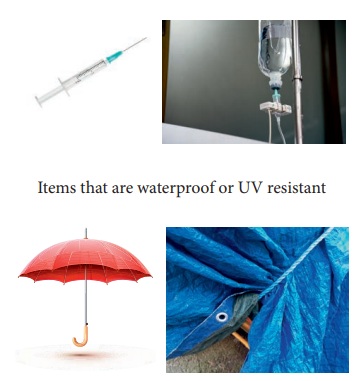
Items that are waterproof or UV resistant
1. Uses of plastics
There are different types of
plastics that are excellent materials when they are used for the right
application. For example, let us take a syringe that is made from a type of
plastic called polypropylene. These syringes do not have to be sterilized and
reused; hence they provide a high standard of hygiene and eliminate the risk of
spreading diseases.
Just as plastic is a material that
can be used for a good application, it can also be used for the wrong
application. Think about the different items you use that are plastic. For
example, a simple
article such as a thin plastic carry bag. You use this bag for a very short
time and then throw it in a dustbin. Many of these carry bags do not get
recycled and they litter and pollute our environment for a long time.
If you want to learn more about
plastic which is used for the wrong application then you can refer to the
Government of Tamil Nadu’s ban on one-time use and throwaway plastics
(Environment and Forests Department, T.N. G.O. No: 84, dated 25/06/2018, with
effect from 1st January 2019).
It is estimated that every year we use a trillion plastic carry bags
(2 million a minute) around the world and out of which only 1 to 3% are
recycled.
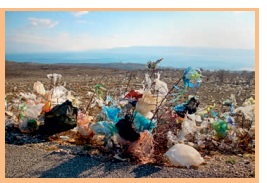
Plastic has been around for less than 200 years. Edmund Alexander
Parkes was the creator of the first plastic called ‘Parkesine’

ACTIVITY 7
Right and wrong
application of plastics
Look at the list of
eight plastic items. Decide which fourplastic itemsare used for the right
application and which four are used for the wrong application by filling in the
chart below:
Plastic items: straws, helmets,
cutlery, thin carry bags, syringes, electrical wires,tea cups and blood bags
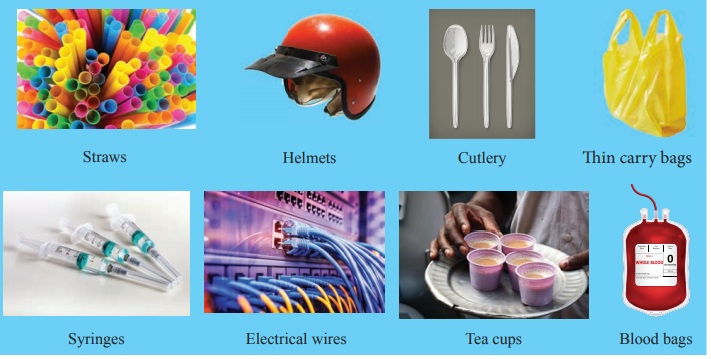
Right application :
Wrong application
Helmets : Straws
Syringes :
Thin carry bags
Electrical wires : Cutlery
Blood bags : Tea cups
2. Types of plastics
The plastics we use in our daily
life are also made up of polymers. All plastics do not have the same type of
arrangement of units. In some articles, the arrangement of a monomer is linear,
and in some other items, the arrangement of articles is cross-linked. Depending
on the type of arrangement, we have two main types of polymers – thermoplastics
and thermoset. Let us see what these are!
Thermoplastics : Polyethylene (also called polythene)
is an example of a plastic. It is used for making polythene carry bags which
are commonly used. When you burn a polythene carry bag, it melts and turns into
liquid along with the production of an offensive odour, a bright flame and
soot. Another example is a PET (Polyethylene Terephthalate) bottle, when
we fill it with boiling water, it gets deformed. Plastics which can be
easily softened and bent when heated are known as thermoplastics. These
plastics can be modified and turned into another plastic item through the
process of recycling.
Thermoset : On the other hand, there are some plastics, which once they are moulded, cannot be softened through heating them. These are called thermosetting plastics. Bakelite and melamine are some examples of thermosetting plastics. Bakelite is a poor conductor of heat and electricity. It is used for making electrical switches and handles of various utensils. Melamine resists fire and can tolerate heat. It is used for making floor tiles and fabrics that resist fire.
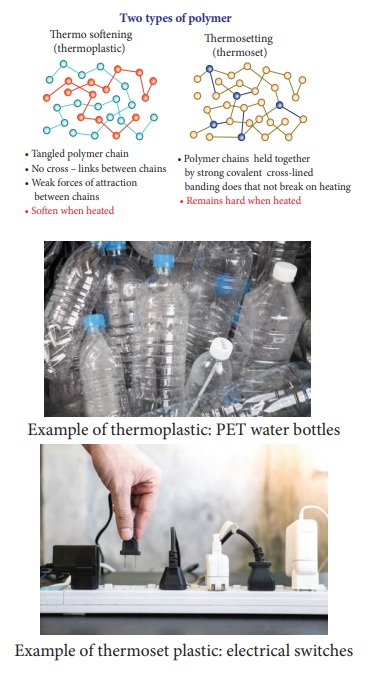
Example of thermoplastic: PET water bottles, Example of thermoset plastic: electrical switches
3. Resin code of plastics
Now that you have learnt about the
differences between Thermoplastic and Thermosetting polymers, let us find out more about
the different types of plastics that you use in your daily life. Plastics are
very useful in our daily life but some types contain dangerous chemicals.
Did you know that there are many
different types of plastics?
You can tell these plastics apart by
searching for a resin code. The resin codes are a universal way of categorising
different types of plastic, which helps us separate plastics so that it is
easier to recycle them. How can you identify the resin code? Where can you find the
resin code on a plastic item?
Look at the chasing arrow
triangle-shaped symbol on the bottom of a bottle, on the brand label sticker or
on the lid of a container. What number is marked in the centre of the triangle?
What letters (acronym) are below this? This is what we call a resin code.
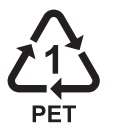
If the number is 1 within the
chasing arrow triangle and/or has the acronym PET or PETE, then it is a type of
plastic which is called PET. Now that you have found out that the bottle has a specific resin
code, let us see what gives the bottle and other plastic products certain
qualities. Different chemicals (additives) are added to plastic to give them
various qualities and characteristics, for example flexibility, strength,
softness or transparency. There are some chemicals that are used in plastics
that are dangerous for our health, animals and the environment. For example,
Polyvinyl Chloride- PVC resin code #3 has heavy metals such as cadmium and lead
which are toxic chemical which are harmful to your health. Polystyrene- PS
resin code #6 has styrene which is a toxic chemical known to cause cancer.
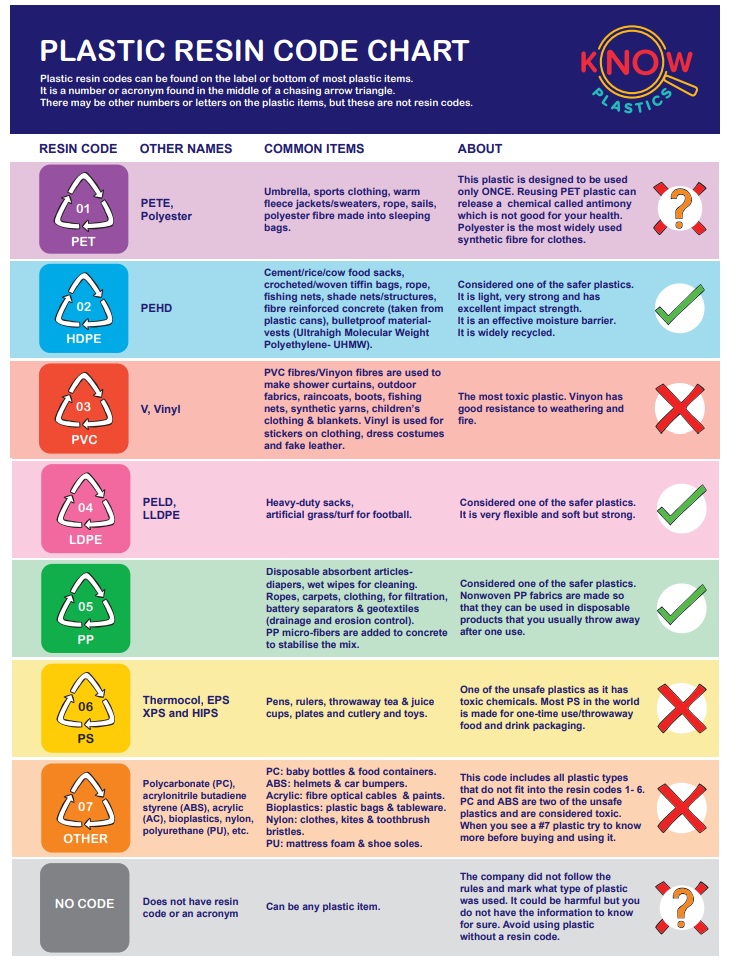
ACTIVITY 8
Identify the different
types of plastics
Collect different
kinds of plastic products and look carefully for the resin code and/or acronym
on them. With the help of the resin code chart,mark the resin code number,
acronym, if you think it is a safer, unsafe or questionable (when you cannot
find the resin code on the article) type of plastic. What resin codes do you
find? Is the resin code safer,unsafe or questionable?

Look at the resin code chart on the
previous page to find out more about the different types of plastic, what are
common items and which plastics are safe and unsafe for us, animals and the
environment.
Look at the resin code chart to find
out more about the different types of plastic, the common items and the
plastics that are safe and unsafe for us, animals and the environment.
4. Impacts of plastics
Plastics are cheap, light weight,
strong and durable and have contributed to a range of advances and benefits to
our modern life. But the increase in the use of plastics, particularly the
one-time use and throwaway plastics has serious impacts on the environment,
animals and our health.
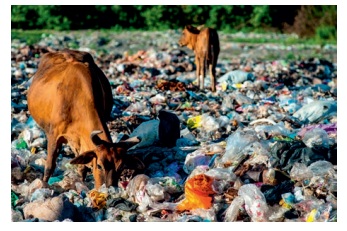
We have seen garbage dumps with
different plastics. One big problem with plastics is that they do not decompose
or biodegrade. This leads to large amounts of waste that will not disappear and
end up accumulating and polluting the environment.
A
lot of one-time use plastic such as polythene bags and food packaging that are
thrown away are responsible for littering the environment and clogging drains.
Standing water breeds mosquitoes that can spread diseases such as malaria,
dengue and chikungunya and also lead to flooding.
Why do you think some animals eat plastic? Many animals confuse plastic for food and eat it by accident. When left over food is thrown away it is often packed in plastic. Animals smell the leftover food and eat the plastic by accident. For example animals in urban areas, particularly cows, often eat polythene plastic bags by accident as they contain food waste. Can you imagine the consequences?
……………………….…………………………
…………………………………………………
A lot of the plastic waste we use
such as plastics bags, bottles and straws end up in the oceans. Plastics in the
ocean are exposed to sunlight, water and the physical movement of
the waves, which
breaks it down in tiny pieces called microplastics. Some microplastics are also
found in household products. Examples are microbeads that can be found in
toothpaste, face wash and body scrubs. Microbeads are washed down in drains and
end up in the soil, rivers, lakes and the ocean Microbeads are washed down in
drains and end up in the soil, rivers, lakes which cause pollution.
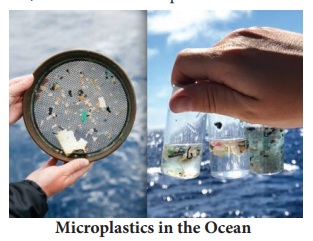
Many birds eat plastic items and
small pieces of plastic, which are covered in algae. Once in the stomach of
animals, plastics cannot be digested and this decreases the amount of space for
food and can lead to starvation. In 2015, plastics were found in 90% of
seabirds.
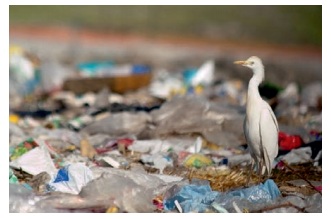
We have already read that Government
of Tamil Nadu has banned one-time use and throwaway plastics such as plastic
carry bags, plates, straws and water pouches. This is an indication that
important efforts are taking place to reduce negative consequences of plastics
on the environment.
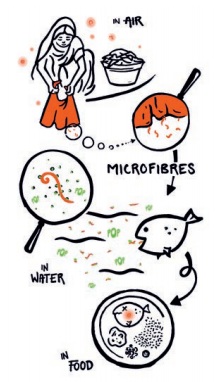
5. PLA Plastics
Can you see how much plastic litter
pollutes our environment? How nice would it be if a material that had similar
qualities to plastic could be biodegradable, be absorbed by the soil and give
nutrients to the soil!
We have seen that synthetic clothes are made from plastic. Every
time we wash synthetic clothes, small fibres called microfibers escape and end
up in the soil, streams, rivers and oceans.
Dangerous pollution called Persistent Organic Pollutants (POPs)
floating in the ocean sticks to these small pieces of plastic making them
toxic. Marine animals such as shrimp and fish often eat microplastics, confusing
them for their natural source of food. The toxins build up in these animals and
move up the food chain and can end up in our bodies. Microplastics can be found
in the food we eat, the water we drink, and the air we breathe.
Yes, scientists have thought about
alternatives to synthetic plastics and have found Poly Lactic Acid (PLA) –a
substitute for some types of plastics. Poly Lactic Acid or polylactide is
compostable and bioactive thermoplastic. This polymer is obtained from plant
starch such as corn, sugarcane and pulp from sugar beets. PLA is a
biodegradable material. It is useful for making food packaging, garbage bags
and disposable table ware.
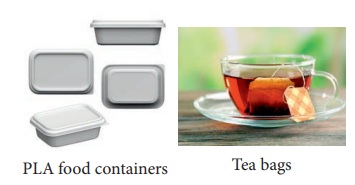
6. Various methods of disposing plastics
Plastics are everywhere! Our
increasing consumption and production of plastic waste needs a solution. Let us
find out more about how and where plastic waste is disposed of and the better
methods of disposing plastics.
Organic waste such as the peels of
vegetables, fruits and food remains can get broken down by bacteria in the soil
to create a rich source of nutrients in the form of compost. A material that
gets decomposed through natural processes and action by bacteria is called
biodegradable.
Plastics do not decompose by natural
processes and action of bacteria and are therefore not biodegradable. It is
important for us to separate our biodegradable and non-biodegradable waste and
dispose of them separately. A lot of the plastic produced globally is designed
to be used only once and thrown away, creating a large amount of plastic
waste. Plastic waste
ends up being recycled, incinerated, landfilled, dumped or ends up littering
our environment. It is estimated that from all the plastic waste ever produced,
79% is in landfills, dumps or in the environment, 12% has been incinerated and
only a small 9% is recycled.
Let us learn more about what happens
with the plastic waste. One way to look at plastic disposal is the 5R Principle
– Refuse, Reduce, Reuse, Recycle and Recover. We have already learned
about the waste pyramid and how the different methods of waste disposal can be
seen in terms of the best option to the least favourable in this order: Refuse
(Avoid), Reduce, Reuse, Recycle, Recover (Compost and Incinerate) and Landfill.
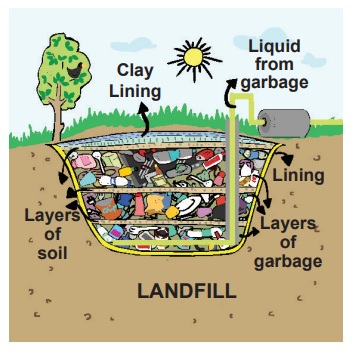
7. Biodegradable plastics
The concept of biodegradable
plastics or bio-plastics was first introduced in the 1980s. Based on the nature
of degradation, there are two main types of plastics: degradable plastic and
compostable plastic.
Degradable plastics are made from
petroleum oil or gas which is the same as conventional plastics. The difference
is that they have a chemical or additive added to them to make them breakdown
faster than conventional plastics when they are exposed to sunlight, oxygen or
water. What do you think will happen to degradable plastics? Degradable
plastics breakdown into tiny pieces called microplastics and these stay in our
environment for a very long time. It is very important to understand that
degradable plastics do not breakdown completely in the environment! Scientists
have found that microplastics in the ocean are really bad and it is likely that
these tiny pieces in the soil are also harmful.
Compostable plastics are derived
from renewable resources such as corn, sugar cane, avocado seeds or shrimp shells.
Compostable plastics can be broken down completely by microbes and turned back
into food for plants-carbon dioxide, methane, water and other natural
compounds.
A recipe for PLA a
compostable plastic!
What you need
i. 1 tablespoon of corn starch
ii. 1 teaspoon of vegetable glycerin (available at the pharmacy)
iii. 1 teaspoon of vinegar (5% acidity)
iv. 4 Tablespoons of water.
v. Cooking spoon
vi. Cooking pot
vii. Stove
viii. Aluminium foil
Method
Mix the water with the starch in a cooking pot. Add the vinegar
and the glycerin. Mix all the ingredients on medium heat. Make sure you
continuously stir. The mixture should turn from liquid white into a clear gel.
When it begins to bubble, then it is ready and should be taken off the stove.
Spread the gel onto the aluminium foil. Let it cool down for one
hour. You can then shape the material to form a cup or bowl. Let the article
you made cool for another 24 hours before you try and use it.
8. Plastic Eating Bacteria
In 2016, scientists from Japan
tested different bacteria from a bottle recycling plant and found that
Ideonellasakaiens is 201-F6 could digest the plastic used to make single-use
drinks bottles that are made of polyethylene terephthalate (PET). The bacteria
works by secreting an enzyme known as ‘PETase’, that breaks down plastic into
smaller molecules. These smaller molecules are then absorbed by the bacteria as
a food source. The working of the enzyme is diagrammatically shown below:
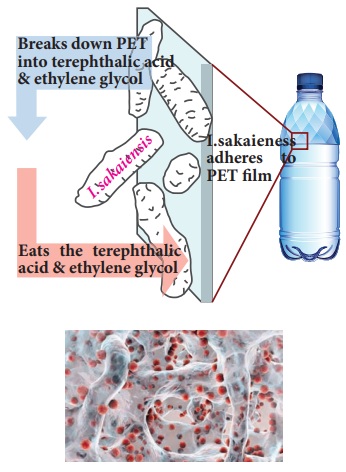
Although the discovery of the
bacteria breaking down plastics is seen as a potential solution to the plastic
pollution – it is still very complex! A big issue is the scale of
the plastic pollution problem. We consume and produce such large quantities of
plastics and this is only increasing. The scale of the bacteria breaking down
plastics is much slower and will therefore not solve the crisis we are facing.
Another limitation is that it is
restricted to PET resin code #1 plastics, which currently is one of the most recyclable
plastics world wide. It will not be a feasible solution to the issue of the
large quantities of non-recyclable low-grade plastics which are polluting the
environment. That is why it cannot be the solution to plastic pollution on its
own!
Related Topics